What Soccer Players Could Learn From Dancers, According to Herman Cornejo
Whenever World Cup season comes around, Herman Cornejo is as happy as a kid on Christmas morning.
“Since I joined ABT 20 years ago, every time there’s a World Cup, we are also at the Met,” says the American Ballet Theatre principal. “It’s the biggest event in soccer happening simultaneously with being able to dance on the Met stage!”
Like most Argentinians, Cornejo grew up playing “the beautiful game,” first with his dad when he was little, then more seriously at school from ages 10 to 14. He was a natural, playing forward because he loved scoring. “For me, it was quite easy,” he says. “But my passion for dance was stronger, so I had to stop playing to prevent any injuries.”
But that doesn’t mean he’s ever lost his love for the game. During this year’s World Cup, he’s rooting for his beloved Argentina—the team plays France on Saturday morning in the first round of the knockout stages. “I’ll be at the theater warming up for Don Q, wearing my Argentina shirt,” says Cornejo.
Despite ABT’s busy performance schedule, he still finds a way to catch most of the matches, typically in his dressing room through an app on his phone or, if he’s in rehearsal, a friend will give him updates from the side of the stage.
Cornejo believes that any dancer—even those that don’t know soccer well— could appreciate the teamwork that happens on the field. “It’s not just about passing the ball and trying to make a goal, it’s the beautiful things in between, the connection between the players,” he says. “It’s the same as in ballet when you have the corps connected to the principals, that’s when a good show comes alive.”
As much as he idolizes soccer players, though, he thinks they could learn a lot from dancers. “We always push to the end. We hide how tired we are, how hard it is what we’re doing,” Cornejo says. “Sometimes you see a soccer player when they are tired, they just stop running.”
He also has an issue with the fad of faking falls to draw a foul: “In ballet, we hide those moments so the audience keeps looking at the good stuff and not when something goes wrong. Of course, in sports, you have to win and that’s what matters. But for me, those moments are important as a human being. If you win by faking something, I wouldn’t feel good about it.”
Even though he hasn’t played a full game in 10 years, Cornejo always keeps a ball in his theater case for whenever he gets a spare moment to kick it around with friends. “When I first joined the company, there used to be about 20 Hispanic dancers, and we’d set up the barres as the goals and play in the studio. Which was not allowed, so we did it when everybody left. It was amazing.”





